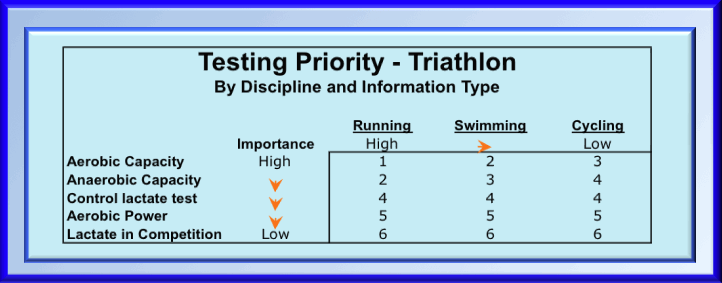Endurance Events and Lactate Testing
With Emphasis on the Triathlon
8 of 19
Lactate tests – Priorities
The following sections discuss different types of lactate tests for triathletes, information provided by these tests, priorities for testing and protocols recommended for recreational, serious and elite competitors.Tests – Priorities
There are many considerations in designing the testing program of a triathlete. Three important factors are:
- A triathlon contains three events, swimming, cycling and running.
- A sport-specific test is needed in order to deduce training information for each of the sports
disciplines. For example, a test for cycling will not work for running.
- It is difficult to conduct a complete specific test for each discipline and not disrupt training.
Thus it is necessary for the coach or athlete to set up priorities for testing. Certain information is more important, and if you have to sacrifice elements of a testing program the following criteria should be used:
Which Disciplines Should You Focus on?
- Running should be the first priority. Running training seems to have the highest risk for making
mistakes and the consequences of these mistakes are the most severe and long lasting. Thus, more
systematic testing time and resources should be allocated to running than to the other two
disciplines.
- Swimming should receive the second emphasis for testing. Errors in swim training are less frequent
and the consequences less severe. The swimmer can recover more easily from the negative consequences
of training mistakes. Moreover many athletes will benefit more from improvements in swimming
technique than from improved conditioning. It is best not to do a test in swimming until good stroke
mechanics have been achieved.
- Testing for cycling is the third priority. This doesn't mean that cycling is less important or that training for cycling should not be as serious. It is obviously very important. This just means that more serious training mistakes are made in running and swimming. We don’t recommend that a triathlete avoid lactate tests in cycling, but the priority is not as great.
These are general rules. It is obvious that if training is focused on one of the 3 sports, it will be more beneficial to test for this discipline, even if it does not match the rules above.
Which Kinds of Information Are Most Needed?
- The first priority for information is aerobic capacity. Since an accurate estimation of this
parameter requires an extensive test protocol as well as a complex interpretation model, a simple
lactate test will only allow one to approximately define this capacity. However, it is possible to
get a good estimation of this capacity with a simple lactate test such as measuring the speed at 4
mmol/l during an effort of least 4 minutes. The strength of the aerobic capacity mainly determines
volume and intensity with minimal risk for over-training.
- The second priority is anaerobic capacity. This will be approximated with a variable related to
anaerobic capacity, such as maximal lactate concentration after a short all-out effort (not more
than 1 minute)
- The next priority is to check by control lactate tests whether the training sets are executed with
the correct intensity.
- The fourth priority is aerobic power or what is known as the maximum lactate steady state. This is
often referred to as the lactate threshold or anaerobic threshold but we are aware that others may
use these terms to represent some other physiological property.
- The last priority for a triathlete is lactate in competition.
The table below represents a combination of the need by discipline and need by type of information. Use it as a guide to set testing priorities. The highest priority in this table is represented by the number 1, which is for a test of aerobic capacity in running. The more time or effort one wants to invest in testing, the more the coach or athlete will be guided by the priority scheme. For the recreational athlete we recommend that they do 1 and 2 and possibly the aerobic capacity test for cycling. For serious triathletes we recommend that the athlete do priorities 1-4. Only for elite athletes do we recommend priority 6. But even for these top-level athletes only some of the test periods will include all the tests.

Continue on to Module 9 which discusses design considerations for a lactate testing protocol.
Module 9 of 19- what are some design considerations for a lactate testing protocol?
